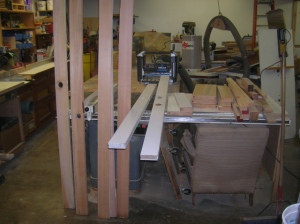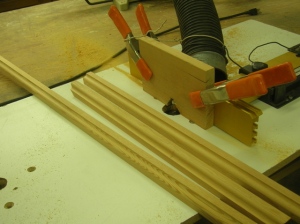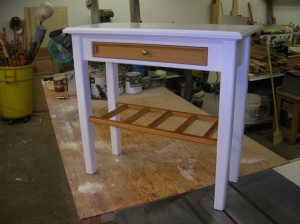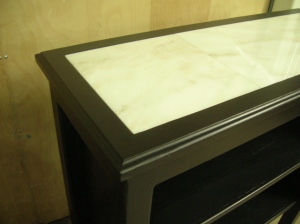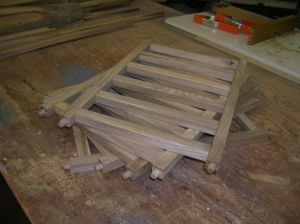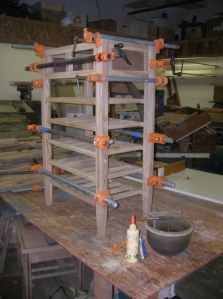In my previous life as a remodeling contractor I did custom design/build work almost exclusively for a wide range of customers and projects. I learned many expensive lessons along the way.
I will try to edit this page as I figure out how to best go about building made to order wine racks, consoles and cabinets, affordably.
Since I constructed the first wine rack in late 1996, I have changed and evolved my designs, methods and materials. I’m sure I will keep changing and tweaking the process of making the racks to increase quality and simplify the process. Because I’m using recycled, reclaimed or found materials for the pieces I build on speculation, the design is modular in nature. This adapts well for custom made pieces too.
If you have ever watched Norm Abram’s show on PBS, The Old Yankee Workshop, you will see him run a part in fifteen seconds and describe what and how he is doing it. Voila, “Now I’m running a piece of trim on the router table with this simple jig I made!” What you never see is that it took him ten minutes or a half an hour to make the jig, then set the machine up with the right bit, run two or three parts trial and error to get the cut right. Sometimes a two day project will be shown in one half hour segment… “And that is how we make our reproduction Victorian sideboard here in D’ Skanky ‘Ol Workchop. ” It’s the machine setups that eat the time, so I have dedicated machines or work stations to make each cut, milling operation or joint as much as I can.
It is always a trade off between having ten router tables with dedicated set-ups, that take up space in the shop, cost money to buy and maintain, or in my case, three routers grouped in a single table that make the the most common cuts. Once they are set, up they never get changed. I have four hand held routers. Two of them with bits that never change and two utility routers, that I change bits frequently to suit the task. I have two table saws, one for general purpose cuts, and one that makes a single dedicated single cut, with a special blade set-up that never changes. It would be nice to have the luxury of a computer controlled factory so I could back a tractor trailer of lumber into one end, and spit out anything I could dream and draw with software… but then I would be a slave to the factory, making it run to support itself. That just ain’t me baby! I want to be as low-tech, low rent as possible and still be creative.
To take custom orders I need basic input:
#1. What kind of material?
Softwood or hardwood? Softwoods are Douglas Fir, Hemlock, Pine, Cedar or Redwood.
Some common hardwoods (some are harder that others) would be Poplar, Alder, Birch, Mahogany, Cherry, Maple, Walnut or Oak. Recycled, reclaimed, salvaged material from my inventory changes all the time.
Or, I can go to one of my local commercial lumber suppliers Crosscut Hardwoods or a specialty supplier like Goby Hardwoods, that deals in exotic highly figured Oregon Black Walnut, White Oak, Madrone, etc. I have had requests for specific kinds of woods such as Cherry or Red Oak to match kitchen cabinets or other furniture. I have applied finishes to match also, from stains to white enamels or black lacquers.
#2. Space or capacity requirements?
You have a wall that is only 24″ wide, a closet that is 30″ wide, a window stool and apron that is 32″ high. Or maybe you want it to act as a console table at 30″ in height or the match kitchen counter height at 36″ or 37″. The small racks can be used on counter tops, at something less than 18″, the typical distance between countertops and wall cupboards, or as end tables at 24″ to 28″. I had a request for a rack that went in a pantry, so it turned out about 26″ wide and 80″ tall, the height of a typical door way.
You have the luxury of abundant space and want capacity. This is how I calculate capacity. The smallest racks are two bottles wide. I typically use them on my small counter top racks. Two shelf racks give you four bottles, three shelf racks give you six, etc. Right now I think the best that I can do would be a ten bottle wide rack.
A single bottle space takes 3 5/8″ so the racks grow width wise in 3 5/8″ increments.
The rack part I call a stretcher is 1″ and I allow 4″ for the bottle space to comfortably load and unload bottles or to pull a bottle part way out to view the label. So I figure the rack shelves in vertical 5″ increments.
The tapered part of the legs on the small counter top racks are less than 3″.
The taller racks usually have the same space as between the racks, measured from the floor to the bottom of the first stretcher. That appears symmetrical, however, many times I want more space, as much as 7″ from the floor to the first stretcher. It gives a more elegant look in my opinion, depending on the overall scale of the piece.
I usually allow 1″ for just a top and 6″ for a drawer carcase/top, in figuring the height of a finished rack.
Usually two legs take 3″ of width, there is an addition shelf cleat of about 1″ and space at each end of the stretcher to space it from the legs. The last thing that goes into calculating the finished rack width is the overhang of the top which is usually 1″, but can be as little as 3/4″ to 1 1/2″… ON EACH SIDE.
All of these measurements can be fudged a bit, but for quick width calculations I multiply the number of bottles times 3.635″ then add 8″ for an extra cleat, end spaces, legs and 1″ overhangs.
A six bottle wide rack would be 29 3/4″ wide. Six racks tall would give you 36 bottles and a finished size of 30″ ( plain rack no drawer). Five racks for 30 bottles and a drawer carcase would give you the same finished height of 30″.
The depth of a typical top is fifteen to sixteen inches. (front to back)
Sound all too confusing? Let me figure it out for you. We can approach this from how many bottles do you want to store, how much space do you have or how do you want the piece to look?
